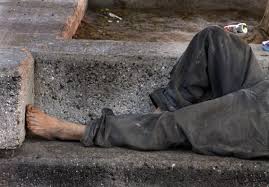
(9-23-19) We’ve all heard the cliche, “The definition of insanity is doing the same thing over and over and expecting different results.”
Yet that often seems what we continue to do when dealing with the chronically homeless and mentally ill.
Which is why I’m always on the lookout for out-of-box ideas. I’d like to cite two examples of such thinking in helping individuals step away from the streets-jail-emergency room treadmill.
The staff at St. Joseph Health became concerned when it kept seeing the same patients cycle through its two hospitals in northern California. It was obvious why. There was no safe place for these chronically homeless and often seriously mentally ill patients to go after they were discharged.
St. Joseph’s Hospital began paying for five beds at a local clean and sober house. That soon grew to fifteen beds. The hospital pays a yearly amount for the building and insurance, screens potential candidates and provides clinical case management for residents during their stay. A community homeless advocate provides 24-hour non clinical staff. Funding for two nurses, a social worker and a health coach — comes out of the hospital’s operations budget.
The goal is to stabilize patients enough to move them out of the program in 21 days, but longer stays occur if needed. St. Joseph’s estimates it saves as much as $1,500 per patient per day by keeping them out of the hospital. And its success rate with patients is good. About half of the homeless who go into respite move into transitional housing with assistance from the team.
According to Healthcare Dive, more and more hospitals are stepping up to deal with homelessness and whittle down accompanying high medical utilization costs. Their efforts range from providing post-discharge respite care to residential case management to donating money to build new housing units for homeless and low-income individuals.
Most successful programs rely on strong community partnerships.
I serve on the board of the Corporation for Supportive Housing, a national organization focused on the homeless, and it estimates that healthcare systems have invested between $75 million and $100 million in housing projects that CSH supports, according to my friend and CSH spokesman Robert Friant, who was quoted in the Healthcare Dive article.
Other examples are cited in the report Housing and the Role of Hospitals published by the American Hospital Association.
In Baltimore, a hospital has invested in more than 700 affordable housing units for the homeless seriously mentally ill to reduce repeated visits.
In Boise Idaho, St Luke’s Health System is collaborating with local groups to develop a single-site Housing First program.
In Chicago, the University of Illinois has partnered with a local mental health provider to provide stable housing to homeless patients it discharges.
I’ve written before about how Section 3025 of the Affordable Care Act established the Hospital Readmissions Reduction Program, which penalizes hospitals for “excess readmissions.” It has spurred hospitals to get into the respite housing arena.
When A Jail Becomes A Homeless Shelter
Greenburger Center Executive Director Cheryl Roberts recently published an OP Ed in the New York Daily News that cited how Albany County Sheriff Craig Apple had broadened his mission from incarceration to provide housing and services to homeless residents.
Twenty-five cells were converted to rooms. Instead of bars, each has a door and its own bed, sink, toilet and television. Clients eat in a communal dining area. Staff from nonprofit organizations and civilians employed by the sheriff’s department provide warm handoff services — outside of the criminal justice system. The cost to reconstruct the cells was $10,000. Items such as televisions and kitchen appliances were donated. The goal is to keep individuals from cycling back into the criminal justice system.
“Chances are Apple’s plan will save Albany County taxpayers hundreds of thousands of dollars a year, make the city safer and save lives,” Roberts writes.
Of course, housing the homeless in jails is unorthodox and makes some advocates uneasy because it can cause further stigmatization. But living on the streets is dangerous and deadly. Studies show the average life expectancy for chronically homeless individuals is in their early 50s.
One reason why the St. Joseph Hospital model and Sheriff Apple’s method appeal to me is they were solutions that originated from the local community up, rather than the federal government down.
I began this blog with the cliche about insanity. I will end it with another quote that I repeat over and over and over again on this blog and in my speeches.
“Never doubt that a small group of thoughtful, committed citizens can change the world: it’s the only thing that every has.” Margaret Mead.



